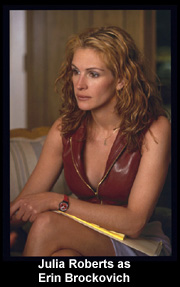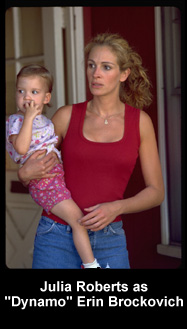- Ysaiah Ross (formerly Stan Ross) is an academic barrister who has
- published a number of books on the legal profession and ethics. Most recent
- are 'The Joke's on ...Lawyers' (Federation Press, 1996) and 'Ethics in Law, 2nd
ed' (Butterworths 1998)
- "
- Besides the preoccupation with the mammary glands the reviews were very favorable and the film was well received.
Many of the reviewers came away with the same wonderful sense of justice I felt after seeing the film.
-
- "
- "
- Thus, in Australia, a highly risky and technically challenging toxic tort case like the one in Erin Brockovich would
probably never be brought at all.
-
- "
-
-
-
|
|
Erin
Brockovich in Australia
by Ysaiah Ross
Erin Brockovich was just released in Australia accompanied by a very
large advertising campaign. The media emphasized Erin’s tits. The social and
political aspects of the film were discussed but there seemed to be a preoccupation with
low cut dresses. There was even a discussion about the fact that Julia Robert’s
breasts had been made to appear larger so as to match up to the real Erin Brockovich.
Besides the preoccupation with the mammary glands the reviews were very favorable and the
film was well received. Many of the reviewers came away with the same wonderful sense of
justice I felt after seeing the film.
For many Australians
Erin’s role as an investigator (paralegal) for a law firm would be a strange role.
This does not mean that Australians cannot accept the concept. There are so many American
lawyer TV programs and films that Australian audiences are used to the different American
methods of legal work. Instead of
having an Erin, Australian firms would have young lawyers doing some of this work.
Investigation in Australian law cases is far less extensive than that done in America. In
New South Wales (Sydney) and Queensland, there are still some law clerks, many of whom are
doing part time law studies, who will help marshal and follow up on evidence for cases.
Most of this work would be done for the large corporations, the defendants in these
actions, who are the clients of these firms. The vast majority of large firms would not
want to take on a tort action against a large corporation for fear of losing their
established clients. There have developed in recent years a few ‘class action’
firms in Sydney and Melbourne that concentrate on bringing mass tort actions. Two of the
most famous actions brought by these firms have been the Australian Dalkon Shield action
and a case against BHP (the largest Australian resource company) for environmental damage
in Papua/New Guinea. A recent action against the tobacco industry was unsuccessful, but
this may change as the state governments get involved. of legal work. Instead of
having an Erin, Australian firms would have young lawyers doing some of this work.
Investigation in Australian law cases is far less extensive than that done in America. In
New South Wales (Sydney) and Queensland, there are still some law clerks, many of whom are
doing part time law studies, who will help marshal and follow up on evidence for cases.
Most of this work would be done for the large corporations, the defendants in these
actions, who are the clients of these firms. The vast majority of large firms would not
want to take on a tort action against a large corporation for fear of losing their
established clients. There have developed in recent years a few ‘class action’
firms in Sydney and Melbourne that concentrate on bringing mass tort actions. Two of the
most famous actions brought by these firms have been the Australian Dalkon Shield action
and a case against BHP (the largest Australian resource company) for environmental damage
in Papua/New Guinea. A recent action against the tobacco industry was unsuccessful, but
this may change as the state governments get involved.
Australia has no central
body that can act to bring separate plaintiffs together in mass tort cases. A few
‘class action’ firms, such as Maurice Blackburn Cashman or Slater & Gordon
perform this role. These firms have staff to follow up and help the individual clients,
but they frequently work on a co-operative model - the client helps in the gathering of
the information and evidence. The clients are also asked for contributions to help towards
the costs of suit.
In Erin Brockovich, the
law firm takes the case only because, if it wins, it earns a very large contingent fee
(40% was the figure mentioned in the film). In Australia, the economics of mass tort
litigation are entirely different. 'In Australia, unlike the United States, percentage
contingent fee contracts are illegal and may be unethical. All Australian jurisdictions
prohibit attorney-client agreements based on a percentage of the award or settlement of
the action. On the other hand, all Australian jurisdictions allow by common law or by
statute speculative actions where a fee is collected only on a successful outcome of the
action. Victoria allows conditional cost agreements with a premium of up to 25% of the
costs otherwise payable except for criminal and family law. New South Wales is similar
except it prohibits such agreements only in criminal law. South Australia allows up to a
100% uplift fee while in Queensland barristers are allowed up to 50%. Tasmania prohibits
an uplift fee for barristers and other jurisdictions have no specific rules on uplift
fees.
Another important difference
between Australian and American law is that in Australia the losing party can be required
to pay the costs of the defendants, including attorneys' fees. In America, on the
other hand, ordinarily each side pays its own fees. The fee-shifting rule in Australia
strongly discourages plaintiffs from attempting risky and costly tort cases. The
combination of the absence of contingent fees together with the attorney fee shifting rule
would probably prevent a case like the one dramatized in Erin Brockovich from ever
being brought at all.
Recently the Queensland
Government asked for submissions on reform of the legal profession. A number of
practitioners requested that the prohibition on percentage contingency fees be removed.
The arguments were that its removal would enhance access to justice by increasing the
willingness of practitioners to take matters on a speculative basis. The Government’s
Green Paper: Legal Profession Reform was released in June 1999 on p 21 rejects this
argument. It states:
It is recognized that the conduct of
legal actions in exchange for a share in the proceeds of the litigation may seem
attractive to some potential litigants. However, the public policy considerations make
contingency fees an unacceptable option. One issue is the absence of a compelling case for
legal practitioners to share in the proceeds from an action rather than to be fairly paid
for their time and costs. There would be particular concern if charging on a share of the
proceeds basis were to become the norm. The practitioner’s interest in the
proceedings could be in conflict with practitioner’s duty to the court. It might
encourage litigation with limited prospects of success motivated by the potential returns
for the practitioners should they be successful or reach a settlement. This would have the
potential to increase the cost of the justice system to the community as a whole and the
implications for the opposing parties would also need to be considered.
These views would have
greater validity if there were adequate legal aid in Australia for bringing speculative
actions. This is not the case and thus many people are denied access to the legal system.
 This situation
can be contrasted to the situation in England concerning mass claims. The English system
is similar to the Australian one concerning the prohibition on percentage contingency fee
contracts and allowing plaintiffs to be subject to possible costs if they lose. However,
the English have provided extensive legal aid for mass tort actions. The have developed
what is called ‘lead actions’ (test cases). Those who decide to register in one
of these cases will be part of the large group getting legal aid. Plaintiffs who refuses
to register can conduct their own case. The disadvantage is that the ‘lead
action’ will be listed and heard first and the individual plaintiff will not receive
legal aid. This situation
can be contrasted to the situation in England concerning mass claims. The English system
is similar to the Australian one concerning the prohibition on percentage contingency fee
contracts and allowing plaintiffs to be subject to possible costs if they lose. However,
the English have provided extensive legal aid for mass tort actions. The have developed
what is called ‘lead actions’ (test cases). Those who decide to register in one
of these cases will be part of the large group getting legal aid. Plaintiffs who refuses
to register can conduct their own case. The disadvantage is that the ‘lead
action’ will be listed and heard first and the individual plaintiff will not receive
legal aid.
The English have also
developed a policy of cooperation for all the various principal agencies, private and
public, that are involved in these cases. The Supreme Court Procedure Committee produced
in 1991 a Guide for Use in Group Action. The guide helps with the managerial
problems that arise in these actions. These include the identification of plaintiff groups
and sub-groups, the transfer of cases from various registries to the registry of the judge
who will be assigned to do little else but look after the particular litigation, the
identification of lead plaintiffs, and lead solicitors for certain issues (one firm, for
example, might handle only the scientific issues flowing from documentary discovery), the
establishment of action committees to communicate with the solicitors and coordinating
Legal Aid and special billing procedures for the solicitors and their groups. [See Aronson
& Hunter, Litigation, 6th ed. 1998]
The Pacific Gas &
Electric case in Erin Brockovich highlights the best aspects of the American
contingency fee system. The Australian media have reported numerous American cases where
lawyers have received outrageous fees from this system, while plaintiffs have been left
with insufficient recoveries. Australian lawyers frequently shake their heads over the
fees earned in these cases and either comment how they have missed out or that these kind
of fees are unconscionable and bring the legal profession throughout the world into
disrepute.
______________
- Ysaiah Ross (formerly Stan Ross) is an
academic barrister who has
- published a number of books on the legal
profession and ethics. Most recent
- are 'The Joke's on ...Lawyers' (Federation
Press, 1996) and 'Ethics in Law,
- 2nd ed' (Butterworths 1998)
|